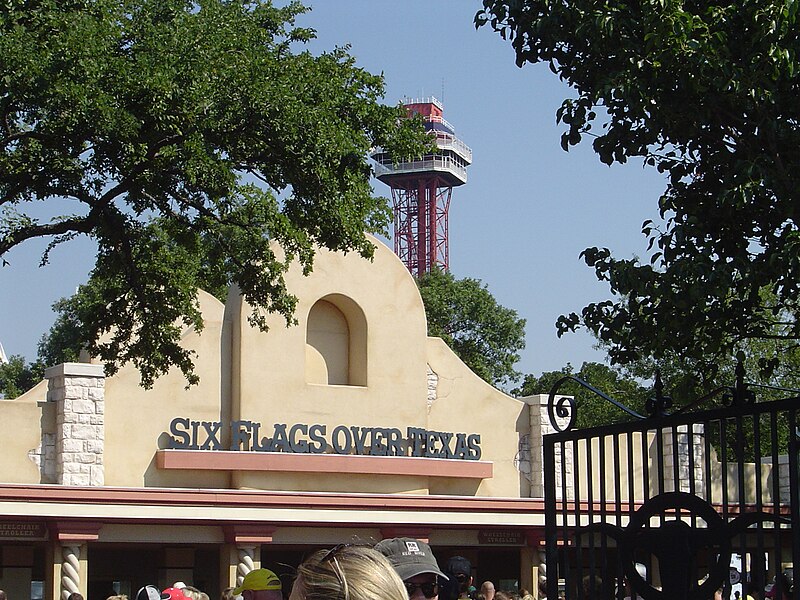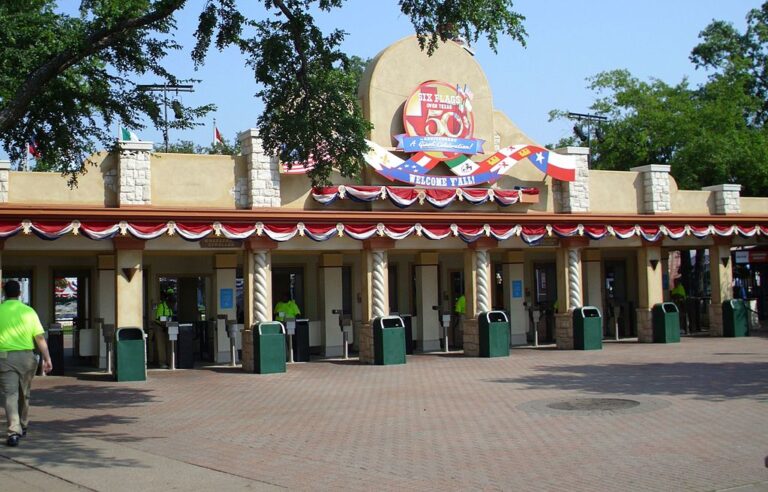Six Flags Over Texas opened in 1961 as one of America’s first successful regional theme parks, created by WWII veteran Angus G. Wynne Jr. You’ll discover how this Arlington hillside transformed entertainment with an early, now-standard “Pay One Price” approach and six themed areas celebrating Texas heritage. From wooden classics to modern mega-thrill rides, the park has evolved while honoring the six nations whose flags flew over Texas. Six decades of memories await as you explore this pioneering entertainment landmark.
Image: Mbrstooge, SFOT Main Park Entrance, CC BY-SA 3.0
From Dream to Reality: Angus Wynne’s Texas-Sized Vision
While many Texans now take Six Flags Over Texas for granted, the iconic amusement park began as one man’s ambitious dream. Angus Wynne Jr., a WWII Navy veteran and successful real-estate developer, envisioned something revolutionary in the late 1950s: a family destination that would celebrate Texas history while offering thrilling experiences.
Unlike Disneyland’s destination model, Wynne’s plan focused on bringing top-tier entertainment closer to where people lived. Through his Great Southwest Corporation, he transformed an Arlington hillside into what would become a landmark regional theme park in 1961. His approach to entertainment development mirrored Houston’s trajectory of rapid growth from small settlements to major attractions.
His community-minded vision extended beyond fun, as he saw Six Flags as a catalyst for economic development. Wynne’s strategy combined cultural pride with business acumen, creating an enduring legacy that would change American entertainment. When Six Flags opened on August 5, 1961, its immediate success validated Wynne’s vision for regional entertainment.
Opening Day 1961: A New Era in Entertainment Begins
As America entered the 1960s, a revolutionary new concept in family entertainment burst onto the scene when Six Flags Over Texas officially opened its gates on August 5, 1961. The grand-opening day welcomed 8,374 visitors, with $2.75 adult and $2.25 child admission to experience the new 205-acre property (with a developed core well under that on opening).
What made this park truly groundbreaking:
-
An early “Pay One Price” model that bundled attractions, reducing reliance on per-ride ticketing
-
Six distinct themed areas representing the flags that flew over Texas, creating immersive experiences throughout the park
-
Carefully choreographed entertainment, from water features at the entrance to performances matching each sovereign’s heritage
Though initially discussed as a limited-run attraction, overwhelming success quickly established Six Flags as a permanent fixture in American entertainment. The park’s first season drew roughly 550,000 visitors before closing for winter on November 25, 1961.
The Six Flags Legacy: Understanding the Historical Namesake

The name “Six Flags Over Texas” carries more historical weight than most amusement-park titles. When you visit, you’re experiencing a theme inspired by the six nations whose flags have flown over Texas: Spain, France, Mexico, the Republic of Texas, the United States, and the Confederate States of America.
Founder Angus G. Wynne Jr. chose this name to celebrate Texas history while creating family entertainment distinct from competitors like Disneyland. The park was designed to provide thrilling fun close to home. The founding of San Antonio in 1718 marked the beginning of sustained European settlement in Texas and frames the Spanish colonial narrative highlighted at the park. Though corporate ownership has changed multiple times since 1961, the name has endured.
In recent years, growing debate over Confederate symbols prompted changes to flag displays—at Over Texas, the park replaced individual historical flags with U.S. flags in 2017—reflecting broader cultural conversations while maintaining the brand’s recognized legacy.
Pioneer of the “Pay One Price” Revolution
Beyond its historical name, Six Flags Over Texas helped popularize a then-novel admission strategy: “Pay One Price.” When the park opened in 1961, a single admission granted broad access to attractions—a sharp departure from the strictly pay-per-ride model common at mid-century parks.
This flat-rate approach delivered three key advantages:
-
Operational efficiencies by streamlining entry and reducing numerous point-of-sale transactions
-
Longer visits as guests experienced more without worrying about incremental costs
-
Predictable revenue that supported reinvestment in bigger, better attractions
This model proved so successful that Six Flags and many peers maintain it today (even as prices reflect inflation). The concept helped transform how theme parks worldwide structure admission.
Landmark Attractions That Defined Generations
Iconic rides and immersive areas have shaped the Six Flags Over Texas experience since 1961. Early coasters included La Cucaracha, a wild-mouse-style favorite. El Aserradero debuted in 1963 as one of the first modern log flumes, pioneering water-ride thrills. The Runaway Mine Train (1966) blended narrative theming with coaster excitement, while Big Bend (1971) became a beloved classic of its era.
Perhaps most influential was the 2011 steel-track conversion of Texas Giant (originally 1990), which introduced RMC’s I-Box technology on a large scale—reshaping wooden-coaster possibilities worldwide and underscoring how Six Flags continually reinvents itself while honoring its heritage.
Evolution of Thrills: From Log Flumes to Mega Coasters
Since its earliest days, Six Flags Over Texas has evolved from simple spinners to engineering showpieces that push the limits. Today’s visit reflects decades of thrill progression.
The park’s journey includes:
-
Early wood and family rides (like log flumes) that balanced broad accessibility with excitement
-
The groundbreaking New Texas Giant transformation completed for the 2011 season, pioneering a major wood-steel hybrid approach
-
The arrival of mega-coasters exceeding 200 feet—headlined by Titan (opened 2001)—bringing massive drops, speed, and airtime once impossible on earlier rides
This evolution mirrors a commitment to innovation while preserving the nostalgic elements that keep generations returning. El Aserradero, still in operation, remains a signature of the park’s early ingenuity.
Behind the Scenes: The Business of Building a Theme Park Empire
The visionary Angus G. Wynne Jr. transformed a real-estate project into an entertainment phenomenon with Six Flags Over Texas. After visiting Disneyland in 1955, he raised capital—alongside partners—to fund a project costed around $10 million (over $100 million in today’s dollars).
Construction began in August 1960 and finished by August 1961, defying skepticism with rapid delivery. The 205-acre site opened with a compact developed core and extensive support facilities. Strong attendance in the inaugural season proved Texas demand for a high-quality regional theme park.
Wynne’s business acumen shined through the early Pay One Price model and regional focus—originally envisioned as a shorter-term venture, Six Flags’ profitability and popularity secured its future and set the stage for a multi-park company.
Cultural Impact: How Six Flags Shaped American Entertainment
While Angus Wynne Jr. built a business, he also crafted a cultural touchstone that reshaped American entertainment. The blend of historical themes and thrilling rides created a template for regional parks that you still experience today.
Six Flags pioneered three transformative approaches:
-
Integrating educational storytelling alongside amusements through themed lands
-
Anchoring regional economic development that helped make Arlington an entertainment hub
-
Emphasizing affordable family experiences over destination-only tourism
The diverse cultural representation of the six themed sections celebrates Texas’s multicultural heritage, making history accessible and fun. What began as a $10 million investment has grown into a company with dozens of parks across North America.
Six Decades of Memories: The Park’s Enduring Appeal
For over six decades, Six Flags Over Texas has evolved from a limited-run idea into a cornerstone of American entertainment culture. Since 1961, the park has refreshed its mix to meet changing guest expectations, balancing thrill coasters with accessible family rides.
What began with $2.75 adult tickets kept its multi-generational charm through seasonal events, refreshed dining (including recent additions like La Creperie, Etienne’s Café, and specialty treats), and thoughtful updates to classics (such as 1992’s Yosemite Sam and the Gold River Adventure makeover of a 1960s dark ride). The pioneering Pay One Price model redefined the industry, while continuous investments keep the experience fresh—securing Six Flags Over Texas as a beloved regional destination.


